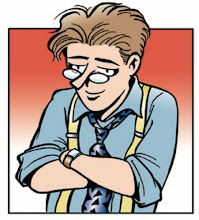He'd always been different from what one might expect a hedge fund manager to be. He wore the same shorts and t-shirts to work for days on end. He refused to wear watches or even his wedding ring. To calm himself at work he often blared heavy metal music. "I think these personal foibles of mine were tolerated among many as long as things were going well, they became signs of incompetence or inability on my part-even among employees and business partners. The partners closest to me tend to ultimately hate me... This business kills a part of life that is pretty essential. The thing is, I haven't identified what it kills. But it is something vital that is dead inside of me. I can feel it" On a portfolio of $550 million he realized profits of greater than $720 million. His investors offered him no praise whatsoever!
Saturday, April 24, 2010
Tuesday, April 13, 2010
THE QUANTS by Scott Patterson (page 197)
There's clear evidence that Wall Street's gluttonous demand for loans and all the fat fees that they spit out was the key factor that allowed, and encouraged, brokers to concoct increasingly risky mortgages with toxic bells and whistles such as adjustable interest rates that shot higher a few years-or in some cases-a few months-after the loan was made. Out of twenty-five of the top subprime mortgage lenders, twenty-one were either owned or financed by major Wall Street or European banks, according to a report by the Center for Public Integrity. Without the demand from the investment banks, the bad loans would never have been made.
Like crack cocaine, it was addictive, and ultimately ruinous. While the boom lasted, securitization helped Wall Street become an increasingly powerful force in the economy. The financial sector's share of the total U.S. corporate profits hit 35 percent in 2007, up from 10 percent in the early 1980's, when quants such as Brown started to arrive at the scene. Financial institutions made up one-fourth of the market cap of the S&P 500, far more than any other industry.
Like crack cocaine, it was addictive, and ultimately ruinous. While the boom lasted, securitization helped Wall Street become an increasingly powerful force in the economy. The financial sector's share of the total U.S. corporate profits hit 35 percent in 2007, up from 10 percent in the early 1980's, when quants such as Brown started to arrive at the scene. Financial institutions made up one-fourth of the market cap of the S&P 500, far more than any other industry.
Wednesday, April 7, 2010
Too Big To Fail by Andrew Ross Sorkin (page157)
In late '97 the so-called flu became a pandemic, Thailand's currency crashed, setting off a financial chain-reaction. Searching for a safe-haven investment, J.P. Morgan pitched a new credit derivative product.
A bank took a basket of hundreds of corporate loans on its books, calculated the risks of these loans defaulting, then tried to minimize its exposure by creating a special purpose vehicle and selling it in slices to investors (a seamless but ominous strategy). They were called insurance: J.P.Morgan was protected from the risk of the loans going bad and investors were paid premiums for taking the risk.
A bank took a basket of hundreds of corporate loans on its books, calculated the risks of these loans defaulting, then tried to minimize its exposure by creating a special purpose vehicle and selling it in slices to investors (a seamless but ominous strategy). They were called insurance: J.P.Morgan was protected from the risk of the loans going bad and investors were paid premiums for taking the risk.
Subscribe to:
Posts (Atom)
